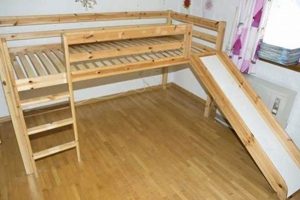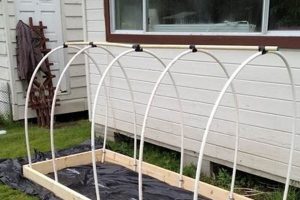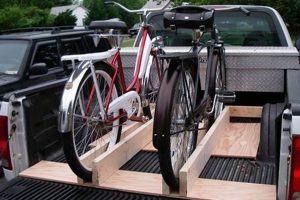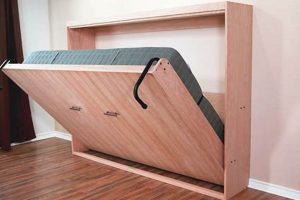The optimal self-applied truck bed coating offers durable protection against abrasion, impact, and chemical exposure. These products are designed for individuals seeking a cost-effective alternative to professional spray-in applications, enabling customization and repair capabilities.
Utilizing a protective layer for a truck bed safeguards against rust, dents, and scratches, thereby preserving the vehicle’s resale value. The implementation of such coatings has evolved from simple drop-in mats to sophisticated spray-on and roll-on formulations offering enhanced adhesion and resilience.
The following sections will delve into the various types of self-applied bed protection available, their respective application methods, performance characteristics, and factors to consider when selecting the appropriate product for a given application.
Application Insights for Self-Applied Truck Bed Protection
Achieving a durable and aesthetically pleasing result with a self-applied truck bed coating requires meticulous preparation and careful execution. The following insights offer guidance for ensuring optimal performance and longevity.
Tip 1: Surface Preparation is Paramount: Thoroughly clean and degrease the truck bed surface. Remove any existing rust, loose paint, or debris using appropriate abrasives. A clean, sound substrate promotes optimal adhesion.
Tip 2: Abrasion for Mechanical Adhesion: After cleaning, abrade the truck bed surface to provide a “tooth” for the coating to grip. Sanding with a medium-grit sandpaper (e.g., 80-grit) is generally recommended. Ensure uniform abrasion across the entire surface.
Tip 3: Masking for a Clean Finish: Protect adjacent surfaces from overspray or drips by carefully masking off areas such as the truck cab, taillights, and bed rails. Use high-quality masking tape and paper or plastic sheeting.
Tip 4: Apply Multiple Thin Coats: Avoid applying the coating in a single thick layer. Instead, apply multiple thin, even coats, allowing each coat to dry according to the manufacturer’s instructions. This minimizes runs, sags, and bubbles.
Tip 5: Temperature and Humidity Considerations: Apply the coating within the temperature and humidity ranges specified by the manufacturer. Extreme temperatures or high humidity can negatively impact the curing process and the final finish.
Tip 6: Proper Mixing is Essential: For two-part coatings, meticulously follow the manufacturer’s mixing instructions. Ensure the components are thoroughly combined to achieve the correct chemical reaction and optimal performance characteristics.
Tip 7: Ventilation is Crucial: Work in a well-ventilated area to avoid inhaling fumes from the coating. Wear appropriate respiratory protection, such as a respirator with organic vapor cartridges.
These application insights highlight the significance of preparation, technique, and environmental factors in achieving a durable and professional-looking self-applied truck bed coating. Adhering to these guidelines maximizes the protective benefits and extends the lifespan of the application.
The subsequent sections will address specific product types and their associated performance attributes, offering a more in-depth understanding of the options available.
1. Durability
The longevity of a self-applied truck bed coating is intrinsically linked to its durability. Durability, in this context, refers to the coating’s ability to withstand the rigors of daily use, exposure to environmental elements, and potential impacts without significant degradation. A coating lacking in durability will exhibit premature wear, leading to increased maintenance requirements and reduced protection for the underlying truck bed.
The cause-and-effect relationship is direct: insufficient durability leads to diminished protection against rust, scratches, dents, and chemical damage. For instance, a bed coating with poor impact resistance may crack or chip when hauling heavy equipment, exposing the metal to corrosion. Similarly, inadequate UV resistance results in fading and embrittlement, reducing the coating’s ability to withstand abrasion and impact. The selection of a durable material is therefore paramount in ensuring the long-term effectiveness of any self-applied truck bed solution.
Ultimately, the selection of a self-applied coating hinges on its ability to endure and provide consistent protection over an extended period. Coatings exhibiting superior formulations, robust chemical bonds, and inherent resistance to environmental factors offer the best long-term value, minimizing the need for frequent repairs or reapplication and ensuring the continued preservation of the truck bed.
2. Adhesion
The effectiveness of any self-applied truck bed protection hinges critically on its ability to form a robust and lasting bond with the underlying truck bed surface. This characteristic, termed adhesion, dictates the coating’s resistance to peeling, chipping, and separation under the stresses of normal use. Insufficient adhesion renders even the most durable coating vulnerable to premature failure, negating its intended protective function. For instance, a bed liner subjected to temperature fluctuations or heavy loads will readily delaminate if the adhesive bond is weak, exposing the bare metal to corrosion and damage. The selection process must therefore prioritize products formulated to establish a tenacious and reliable bond with the prepared truck bed surface.
Surface preparation plays an indispensable role in achieving optimal adhesion. Removing contaminants such as grease, oil, and rust is paramount. Abrading the surface to create a textured profile enhances mechanical interlocking between the coating and the metal. Furthermore, the compatibility of the primer or bonding agent with both the substrate and the topcoat dictates the strength and longevity of the adhesive interface. Consider, for example, a scenario where a truck bed is coated with a product incompatible with aluminum. The resultant weak bond will lead to rapid deterioration, even under mild use. Real-world examples underscore the significance of careful surface preparation and material selection to optimize adhesion.
In summary, adhesion is not merely a desirable attribute but a fundamental prerequisite for a functional and enduring self-applied truck bed coating. The interplay between surface preparation, material compatibility, and the coating’s inherent adhesive properties collectively determines its ability to withstand the rigors of daily use and provide sustained protection. Overlooking this critical aspect compromises the investment and jeopardizes the integrity of the truck bed.
3. UV Resistance
Ultraviolet (UV) radiation, a component of sunlight, presents a significant degradation risk to organic materials, including many polymers used in self-applied truck bed coatings. Prolonged exposure causes chain scission, crosslinking, and discoloration, leading to embrittlement, cracking, and loss of protective properties. A bed coating lacking adequate UV resistance will exhibit accelerated wear, requiring premature replacement. A truck bed subjected to intense sunlight will experience significant temperature variations, further exacerbating UV-induced degradation. The inclusion of UV stabilizers, such as hindered amine light stabilizers (HALS) and UV absorbers, mitigates these effects. These additives function by either scavenging free radicals generated by UV radiation or by absorbing UV radiation and dissipating it as heat, thereby protecting the polymer matrix. Consequently, UV resistance constitutes a critical performance criterion for assessing the value of a self-applied solution.
The absence of UV resistance manifests in various ways. Fading of the coating’s color is an early indicator, followed by the development of surface cracks and a reduction in flexibility. Over time, the coating may become brittle and prone to chipping or peeling, exposing the underlying metal to corrosion. This degradation cycle necessitates frequent reapplication, increasing maintenance costs and downtime. A bed coated with a UV-resistant product, however, will maintain its integrity for a significantly longer duration, providing sustained protection against abrasion, impact, and chemical exposure. Consider, for example, two identical trucks, one with a UV-stabilized coating and the other without. After several years of exposure to the same environmental conditions, the truck with the UV-stabilized coating will exhibit significantly less degradation and superior overall protection.
In summation, UV resistance is an indispensable characteristic of any self-applied truck bed coating intended for long-term protection. The inclusion of appropriate UV stabilizers in the formulation is paramount in mitigating the deleterious effects of sunlight exposure. Evaluating a product’s UV resistance rating and verifying the presence of UV-stabilizing additives is essential in ensuring the longevity and performance of the coating. Neglecting this critical factor results in premature degradation, increased maintenance, and compromised protection for the truck bed.
4. Abrasion Resistance
Abrasion resistance is a pivotal attribute defining a superior self-applied truck bed protection. Its direct influence on the longevity and protective capability of the coating necessitates careful consideration during product selection. A coating lacking adequate abrasion resistance will exhibit premature wear, reducing its ability to safeguard the underlying truck bed from damage. The cause-and-effect relationship is straightforward: insufficient abrasion resistance leads to scratching, gouging, and erosion of the coating, ultimately exposing the metal to corrosion and impact damage. This is particularly critical in applications involving frequent transport of abrasive materials such as gravel, sand, or construction debris.
The consequences of inadequate abrasion resistance are readily observable in real-world scenarios. Consider two identical trucks used in the construction industry, one equipped with a coating exhibiting high abrasion resistance and the other with a less resistant product. After a year of comparable use, the truck bed coated with the less abrasion-resistant material will show significantly more surface damage, including scratches, gouges, and potential bare metal exposure. This directly translates to increased maintenance costs, reduced resale value, and a higher risk of structural damage to the truck bed itself. The selection of a product formulated to withstand abrasive forces is therefore paramount in ensuring long-term protection and minimizing operational expenses.
In conclusion, abrasion resistance is not merely a desirable feature but a fundamental requirement for any self-applied truck bed protection intended for demanding applications. The ability to withstand abrasive wear dictates the coating’s ability to provide sustained protection over its service life. When evaluating options, prioritizing products with verified abrasion resistance ratings and robust formulations is essential in achieving a cost-effective and durable solution. Overlooking this critical factor results in premature wear, increased maintenance, and ultimately compromises the integrity of the truck bed, undermining the purpose of the protection itself.
5. Ease of Application
The practicality of self-applied truck bed coatings is intrinsically linked to the ease with which they can be applied by individuals lacking specialized equipment or professional training. This factor directly influences the success rate and overall satisfaction associated with such products.
- Surface Preparation Simplicity
The complexity of surface preparation significantly impacts the accessibility of a coating. Products requiring extensive sanding, etching, or specialized cleaning procedures present a barrier to entry for many users. Coatings that minimize preparation steps while still ensuring adequate adhesion are generally favored.
- Application Method Intuitiveness
The application method itself whether roll-on, brush-on, or spray-on dictates the learning curve and potential for errors. Roll-on applications are generally considered the most forgiving, while spray-on applications often require specific equipment and technique to achieve an even finish. The degree of user expertise required directly influences the perceived ease of application.
- Curing Time and Environmental Sensitivity
Extended curing times or sensitivity to temperature and humidity introduce complexities. Coatings that require precise environmental conditions or prolonged drying periods increase the risk of imperfections and extend the project timeline. Products with shorter, more forgiving curing windows are generally preferred.
- Mixing Process Clarity
For two-part coatings, the mixing process must be clearly defined and readily executed. Ambiguous instructions or complex mixing ratios increase the likelihood of errors, potentially compromising the coating’s performance characteristics. Simple, straightforward mixing procedures enhance the user experience and minimize potential for failure.
Ultimately, the selection of a truck bed coating necessitates a balance between performance attributes and ease of application. While durability and protection are paramount, a product that is excessively difficult to apply may deter individuals from attempting a self-installation, thus negating its potential benefits.
6. Cost-Effectiveness
The concept of “Cost-Effectiveness”, when considered alongside a self-applied truck bed coating, encompasses more than merely the initial purchase price. It necessitates a comprehensive evaluation of the total cost of ownership, including material expenses, application time, required tools, and the coating’s expected lifespan. A seemingly inexpensive product may prove to be less cost-effective in the long run if it requires frequent reapplication or fails to provide adequate protection, leading to underlying damage to the truck bed. Therefore, selecting a solution necessitates a balanced approach, weighing upfront costs against durability and long-term performance.
Consider two contrasting scenarios. The first involves a low-cost coating requiring reapplication every year due to poor abrasion resistance and UV degradation. Over a five-year period, the cumulative cost of materials and labor will likely exceed that of a higher-priced, more durable coating with a projected lifespan of five years or more. Furthermore, the downtime associated with frequent reapplication can be a significant indirect cost, particularly for individuals who rely on their trucks for commercial purposes. In the second scenario, a coating with a higher upfront investment but superior protective qualities safeguards the truck bed against corrosion and impact damage, preserving its structural integrity and maintaining the vehicle’s resale value.
In summary, “Cost-Effectiveness” is a multifaceted consideration when selecting a DIY truck bed protection. A thorough analysis must extend beyond the initial price tag to encompass factors such as durability, application ease, and long-term performance. While budget constraints are undeniable, prioritizing a cost-effective solution ultimately entails maximizing the return on investment by selecting a product that provides reliable and enduring protection for the truck bed. This approach minimizes maintenance, preserves vehicle value, and ensures long-term satisfaction.
Frequently Asked Questions
The following questions address common inquiries regarding self-applied truck bed coatings, providing clarity on their application, performance, and suitability for various uses.
Question 1: What level of surface preparation is truly necessary before applying a self-applied truck bed coating?
Adequate surface preparation is paramount. The surface must be thoroughly cleaned to remove any grease, oil, rust, or loose paint. Abrading the surface with sandpaper (typically 80-grit) is essential to create a profile for proper adhesion. Failure to adequately prepare the surface will result in premature coating failure.
Question 2: Are self-applied bed coatings as durable as professionally applied spray-in liners?
While some self-applied coatings offer considerable durability, professionally applied spray-in liners generally provide superior impact and abrasion resistance due to their specialized application equipment and formulations. However, advancements in self-applied coatings have narrowed the performance gap, particularly for light to medium-duty applications.
Question 3: How long does a self-applied truck bed coating typically last?
The lifespan of a self-applied coating varies considerably based on the product formulation, application quality, and usage conditions. Under typical conditions, a properly applied coating can last from 1 to 5 years. Frequent exposure to harsh chemicals, abrasive materials, or extreme weather conditions will reduce its lifespan.
Question 4: What are the key differences between roll-on and spray-on self-applied bed coatings?
Roll-on coatings are generally easier to apply, require less specialized equipment, and are more forgiving in terms of application technique. Spray-on coatings offer a more textured finish and can reach difficult-to-access areas more effectively. However, they typically require an air compressor and spray gun, and demand greater skill to achieve a uniform application.
Question 5: Is it possible to repair a damaged self-applied truck bed coating?
Yes, minor damage such as scratches or small chips can often be repaired using touch-up kits specifically designed for the coating. Larger areas may require more extensive repairs, involving sanding, cleaning, and reapplication of the coating in the affected area.
Question 6: What safety precautions should be taken during the application of a self-applied truck bed coating?
Appropriate safety precautions include working in a well-ventilated area, wearing a respirator equipped with organic vapor cartridges, wearing eye protection, and wearing gloves to prevent skin contact. Adhering to the manufacturer’s safety guidelines is essential.
The information provided in this FAQ section aims to address prevalent concerns and provide a foundational understanding of self-applied truck bed protection. Careful consideration of these factors is vital for making informed decisions and achieving satisfactory results.
The subsequent section will provide practical guidance on selecting the right coating.
Conclusion
The preceding discussion has elucidated critical factors for individuals considering a self-applied truck bed coating. The selection of the best diy bed liner is not merely a matter of cost but a careful evaluation of durability, adhesion, UV resistance, abrasion resistance, application ease, and overall cost-effectiveness. Each aspect contributes to the coating’s ability to protect the truck bed and extend its service life.
Individuals must diligently assess their specific needs and operating conditions before making a product choice. Informed decision-making, coupled with meticulous application, is paramount to maximizing the long-term benefits of a self-applied truck bed coating and safeguarding the integrity of the vehicle. Continued advancements in material science promise further improvements in the performance and longevity of these coatings.







